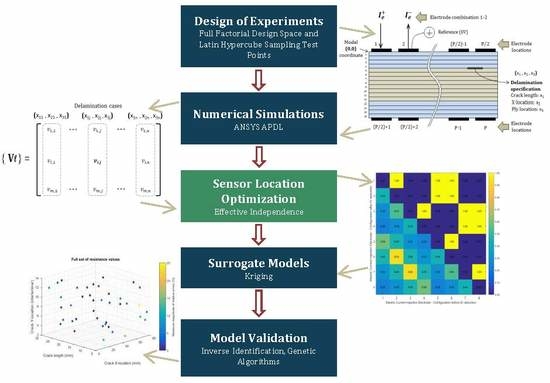Optimal Electrode Selection for Electrical Resistance Tomography in Carbon Fiber Reinforced Polymer Composites
Abstract
:1. Introduction
2. Electrical Resistance Tomography in CFRP Composite Laminates
3. Effective Independence for Optimum Sensor Location Selection
4. Problem Formulation and Solution
4.1. Effective Independence Applied to Electric Resistance Tomography Measurements
4.2. Solving the Forward Problem in ERT to Simulate Resistance Measurements
4.3. Selection of Optimum Set of Electrode Pairs for ERT Based NDE Using Effective Independence
4.4. Validation of Electrode Pair Reduction Using Inverse Identification
5. Results and Discussion
5.1. Effective Independence Applied to ERT
5.2. Inverse Identification of Damage in the Composites
6. Conclusions
Acknowledgments
Author Contributions
Conflicts of Interest
Abbreviations
| CFRP | Carbon Fiber Reinforced Polymer |
| NDE | Non-Destructive Evaluation |
| ERT | Electrical Resistance Tomography |
| DOF | Degrees of Freedom |
| EI | Effective Independence |
| PCA | Principal Component Analysis |
| SVD | Singular Value Decomposition |
| BC | Boundary Condition |
| FEM | Finite Element Method |
| FEA | Finite Element Analysis |
| APDL | ANSYS Parametric Design Language |
| GA | Genetic Algorithm |
| DOE | Design of Experiments |
| RE | Relative Error |
| LHS | Latin Hypercube Sampling |
| RMS | Root Mean Square |
| RMSE | Root Mean Square Error |
References
- Ibrahim, M. Nondestructive evaluation of thick-section composites and sandwich structures: A review. Compos. Part A Appl. Sci. Manuf. 2014, 64, 36–48. [Google Scholar] [CrossRef]
- Todoroki, A.; Omagari, K.; Shimamura, Y.; Kobayashi, H. Matrix crack detection of CFRP using electrical resistance change with integrated surface probes. Compos. Sci. Technol. 2006, 66, 1539–1545. [Google Scholar] [CrossRef]
- Todoroki, A. Delamination monitoring analysis of CFRP structures using multi-probe electrical method. J. Intell. Mater. Syst. Struct. 2008, 19, 291–298. [Google Scholar] [CrossRef]
- Todoroki, A.; Tanaka, M.; Shimamura, Y. Measurement of orthotropic electric conductance of CFRP laminates and analysis of the effect on delamination monitoring with an electric resistance change method. Compos. Sci. Technol. 2002, 62, 619–628. [Google Scholar]
- Todoroki, A.; Tanaka, M.; Shimamura, Y. High performance estimations of delamination of graphite/epoxy laminates with electrical resistance change method. Compos. Sci. Technol. 2003, 63, 1911–1920. [Google Scholar] [CrossRef]
- Todoroki, A.; Tanaka, Y.; Shimamura, Y. Multi-prove electric potential change method for delamination monitoring of graphite/epoxy composite plates using normalized response surfaces. Compos. Sci. Technol. 2004, 64, 749–758. [Google Scholar] [CrossRef]
- Todoroki, A.; Ueda, M. Low-cost delamination monitoring of CFRP beams using electrical resistance changes with neural networks. Smart Mater. Struct. 2003, 15, N75. [Google Scholar] [CrossRef]
- Kammer, D. Sensor placement for on-orbit modal identification and correlation of large space structures. J. Guid. Control Dyn. 1991, 14, 251–259. [Google Scholar] [CrossRef]
- Todoroki, A.; Tanaka, Y. Delamination Identification of cross-ply graphite/epoxy composite beams using electric resistance change method. Compos. Sci. Technol. 2002, 62, 629–639. [Google Scholar] [CrossRef]
- Silva, O.L.; Lima, R.G.; Martins, T.C.; de Moura, F.S.; Tavares, R.S.; Tsuzuki, M.G. Influence of current injection pattern and electric potential measurement strategies in electrical impedance tomography. Control Eng. Pract. 2017, 58, 276–286. [Google Scholar] [CrossRef]
- Selvakumaran, L.; Long, Q.; Prudhomme, S.; Lubineau, G. On the detectability of transverse cracks in laminated composites using electrical potential change measurements. Compos. Struct. 2015, 121, 237–246. [Google Scholar] [CrossRef]
- Todoroki, A.; Tanaka, Y.; Shimamura, Y. Delamination monitoring of graphite/epoxy laminated composite plate of electric resistance change method. Compos. Sci. Technol. 2002, 62, 1151–1160. [Google Scholar] [CrossRef]
- Kammer, D.; Tinker, M. Optimal placement of triaxial accelerometers for modal vibration tests. Mech. Syst. Signal Process. 2004, 18, 29–41. [Google Scholar] [CrossRef]
- Somersalo, E.; Cheney, M.; Isaacson, D. Existence and Uniqueness for Electrode Models for Electric Current Computed Tomography. SIAM J. Appl. Math. 1992, 52, 1023–1040. [Google Scholar] [CrossRef]
- Kim, B.; Boverman, G.; Newell, J.; Saulnier, G.; Isaacson, D. Optimal placement of triaxial accelerometers for modal vibration tests. Physiol. Meas. 2007, 28, S57–S69. [Google Scholar] [CrossRef] [PubMed]
- Baltopoulos, A.; Polydorides, N.; Pambaguian, L.; Vavouliotis, A.; Kostopoulos, V. Damage identification in carbon fiber reinforced polymer plates using electrical resistance tomography mapping. J. Compos. Mater. 2013, 47, 3285–3301. [Google Scholar] [CrossRef]
- Jones, D.; Schonlau, M.; Welch, W. Efficient Global Optimization of Expensive Black-Box Functions. J. Global Opt. 1998, 13, 455–492. [Google Scholar] [CrossRef]
- Sacks, J.; Welch, W.; Mitchell, T.; Wynn, H. Design and Analysis of Computer Experiments. Stat. Sci. 1989, 4, 409–423. [Google Scholar] [CrossRef]
- Diaz-Montiel, P. Exploration on Surrogate Models for Inverse Identification of Delamination Cracks in CFRP Composites Using Electrical Resistance Tomography. Master’s Thesis, San Diego State University, San Diego, CA, USA, 2016. [Google Scholar]
- Deoras, A. Customizable Heat Maps. 2014. Available online: https://www.mathworks.com/matlabcentral/fileexchange/24253-customizable-heat-maps/content/html/heatmap_examples.html (accessed on 16 August 2016).

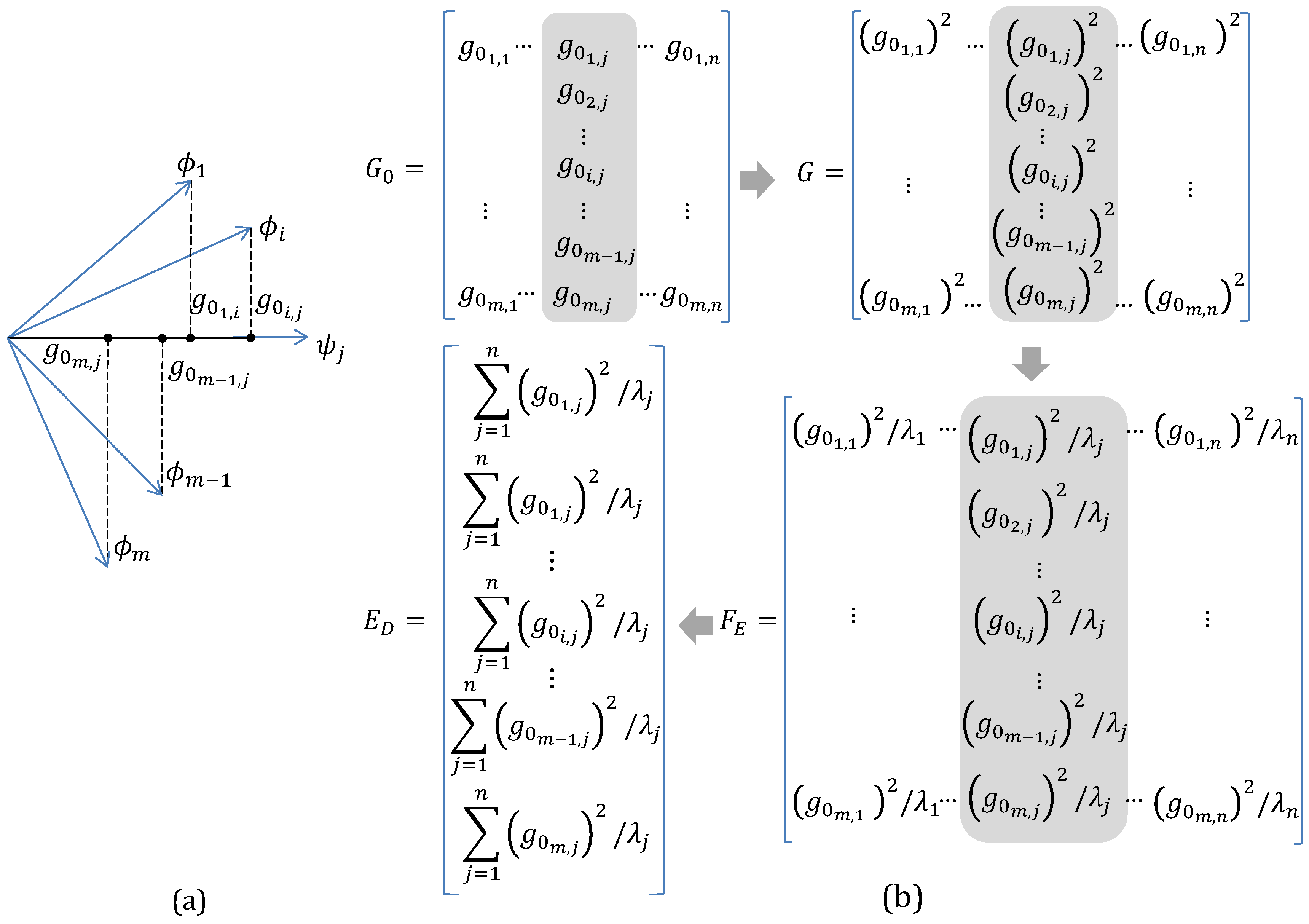

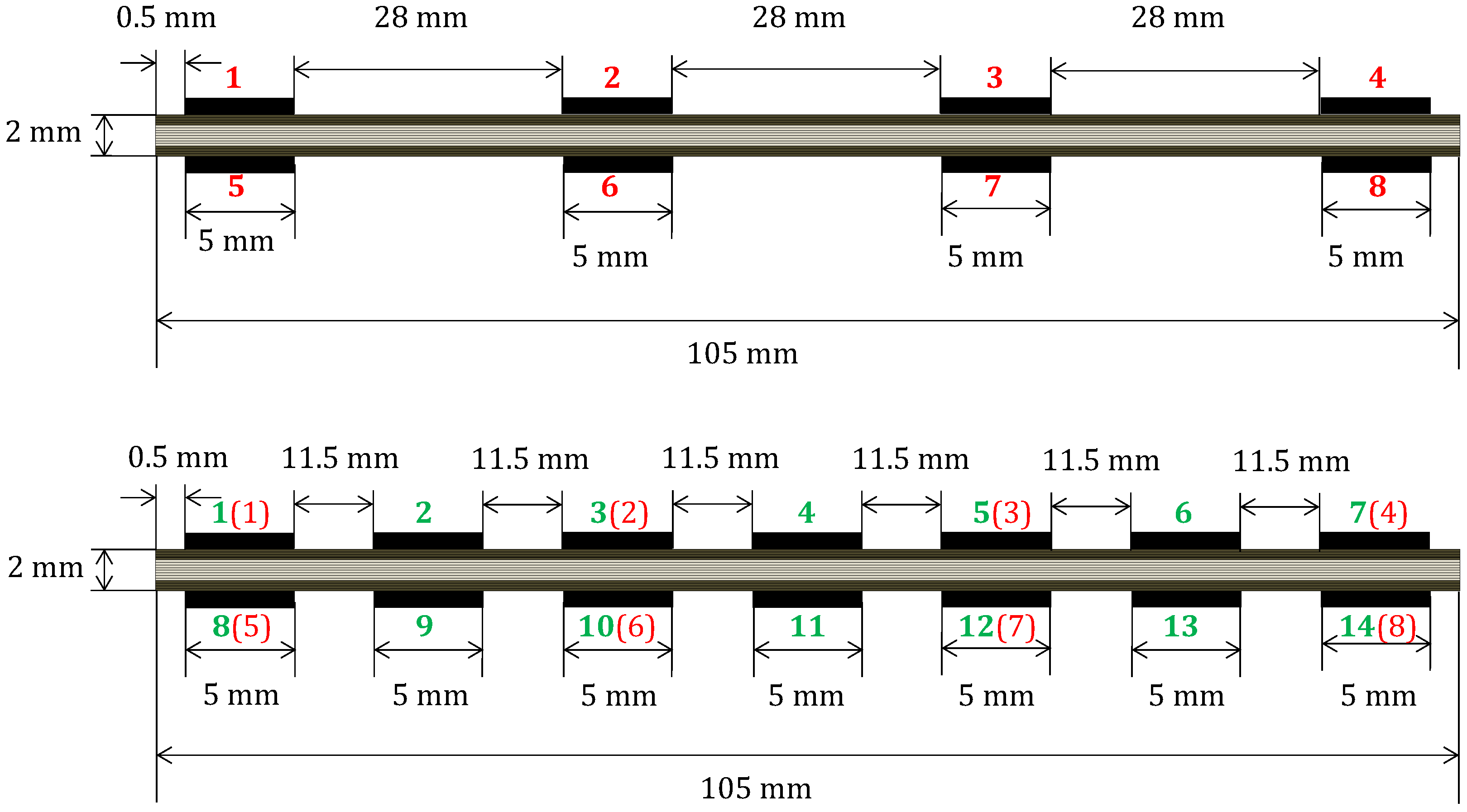
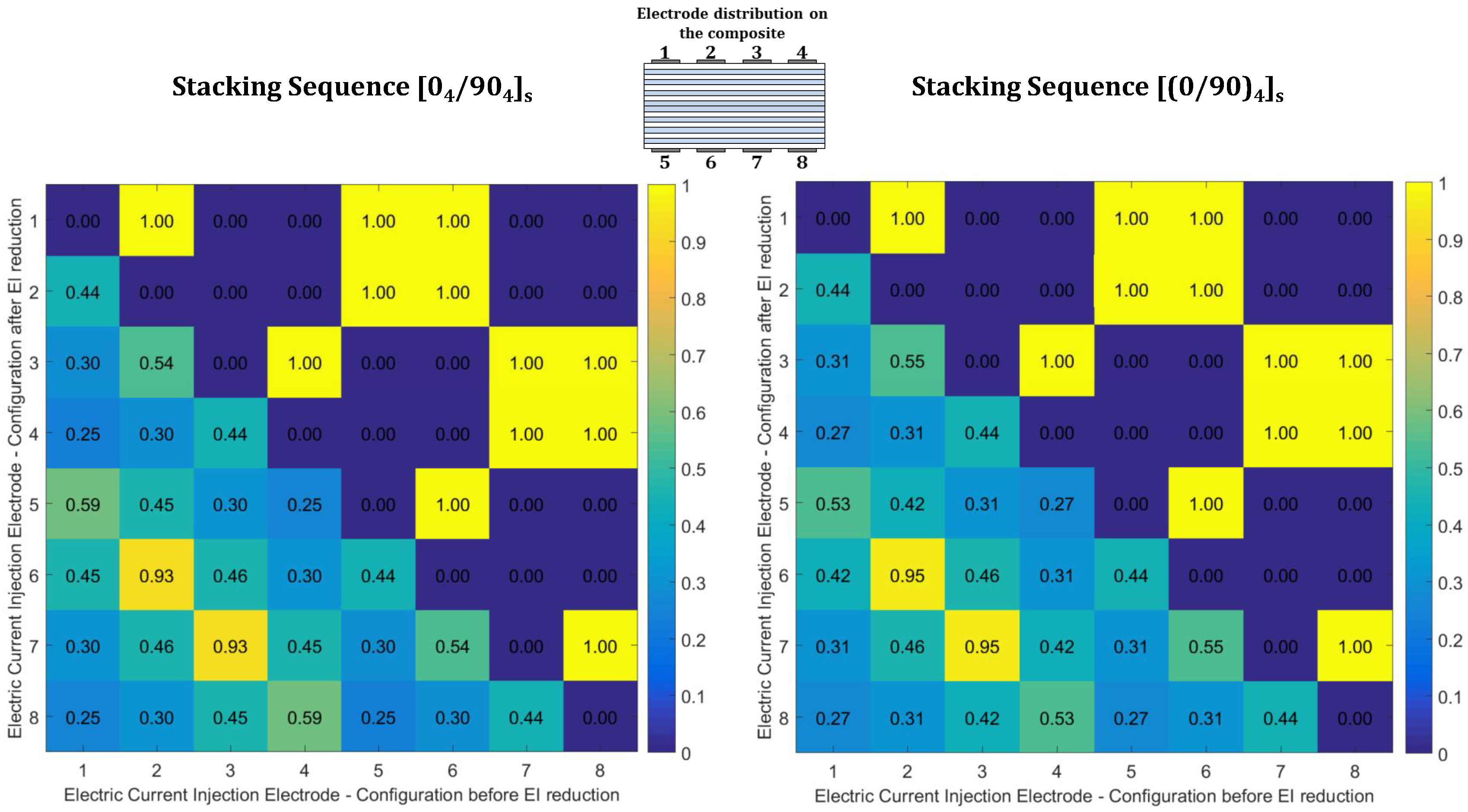
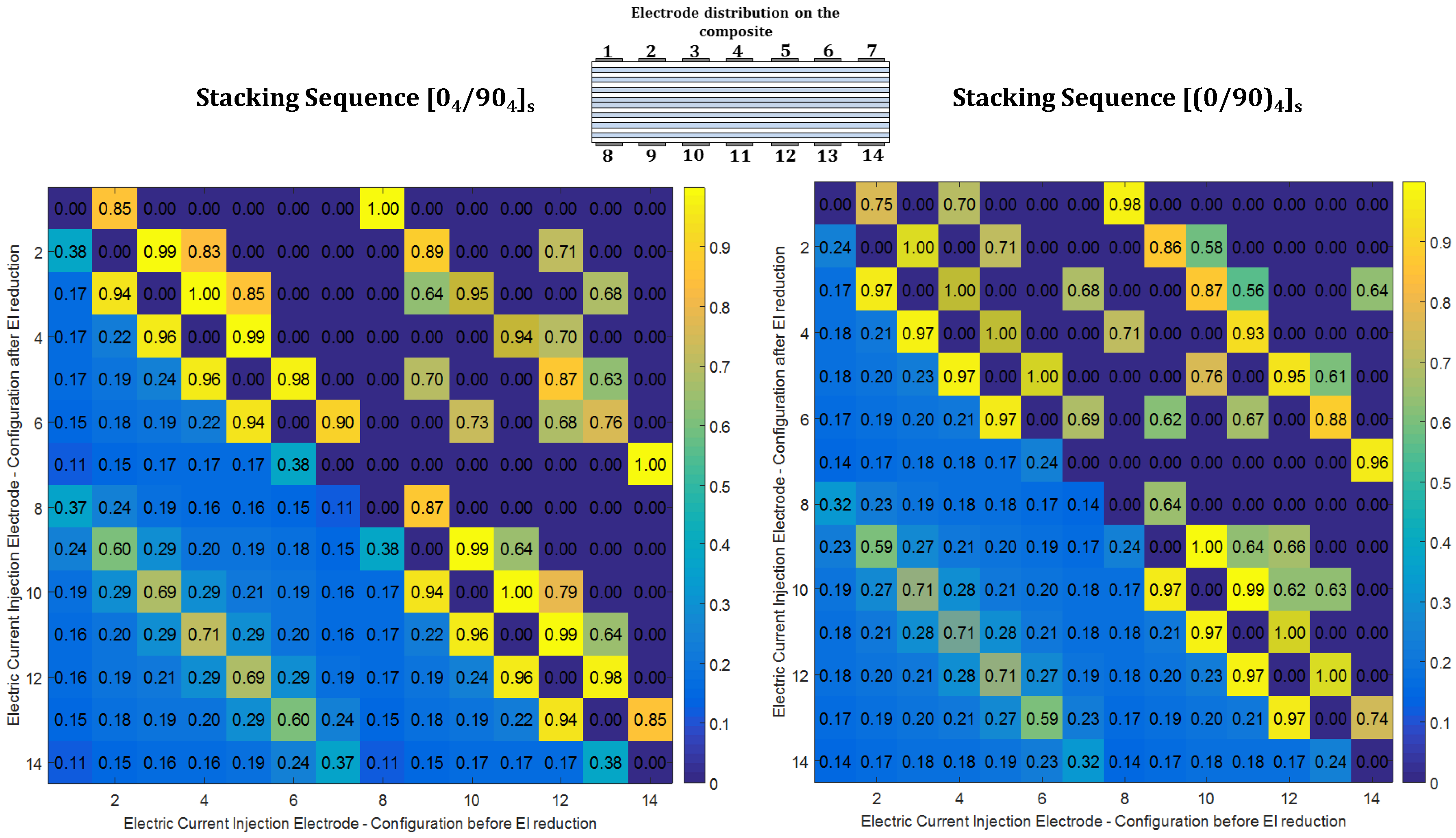




| Fiber Direction ( ) | Transverse to Fiber Inplane ( ) | Transverse to Fiber Normal to ply ( ) |
|---|---|---|
| 5500 | 203.5 | 20.9 |
| Design Variable Description | Type | |||
|---|---|---|---|---|
| Crack Size, in (mm) | Continuous | 5 | 30 | |
| Crack x-location, in (mm) | Continuous | 4.5 | 83 | |
| Crack y-location, interlaminar | Discrete | 1 | 15 |
| Number of Groups and Group Description for Both [04/904]s and [(0/90)4]s Layups | ||
|---|---|---|
| Ei Range | Number of Groups | Group description (Injection/Ground) |
| Ei ≥ 0.9 | 1 | (2/6 , 3/7) |
| 0.9 > Ei ≥ 0.5 | 2 | (1/5 , 4/8) and (2/3 , 6/7) |
| 0.5 > Ei ≥ 0.4 | 3 | (2/7 , 3/6) ; (1/6 , 2/5 , 3/8 , 4/7) and (1/2 , 3/4 , 5/6 , 7/8) |
| 0.4 > Ei ≥ 0.3 | 1 | (1/7 , 2/8 , 1/3 , 2/4 , 3/5 , 4/6 , 5/7 , 6/8) |
| 0.3 > Ei ≥ 0.2 | 1 | (1/8 , 1/4 , 5/8 , 4/5) |
| Layup | Number of Electrodes | Electrode Set | RMSE of Maximum Relative Errors (%) | Maxima of Maximum Relative Errors (%) | Number of Cases with |
|---|---|---|---|---|---|
| 8 | Full | 10.42 | 50 | 6 | |
| 8 | Reduced | 8.09 | 37.5 | 6 | |
| 14 | Full | 5.11 | 25 | 5 | |
| 14 | Reduced | 6.02 | 27.38 | 5 | |
| 8 | Full | 5.22 | 19.43 | 5 | |
| 8 | Reduced | 7.65 | 33.78 | 6 | |
| 14 | Full | 5.31 | 32.69 | 1 | |
| 14 | Reduced | 3.37 | 16.09 | 1 |
© 2017 by the authors. Licensee MDPI, Basel, Switzerland. This article is an open access article distributed under the terms and conditions of the Creative Commons Attribution (CC BY) license ( http://creativecommons.org/licenses/by/4.0/).
Share and Cite
Escalona Galvis, L.W.; Diaz-Montiel, P.; Venkataraman, S. Optimal Electrode Selection for Electrical Resistance Tomography in Carbon Fiber Reinforced Polymer Composites. Materials 2017, 10, 125. https://doi.org/10.3390/ma10020125
Escalona Galvis LW, Diaz-Montiel P, Venkataraman S. Optimal Electrode Selection for Electrical Resistance Tomography in Carbon Fiber Reinforced Polymer Composites. Materials. 2017; 10(2):125. https://doi.org/10.3390/ma10020125
Chicago/Turabian StyleEscalona Galvis, Luis Waldo, Paulina Diaz-Montiel, and Satchi Venkataraman. 2017. "Optimal Electrode Selection for Electrical Resistance Tomography in Carbon Fiber Reinforced Polymer Composites" Materials 10, no. 2: 125. https://doi.org/10.3390/ma10020125





